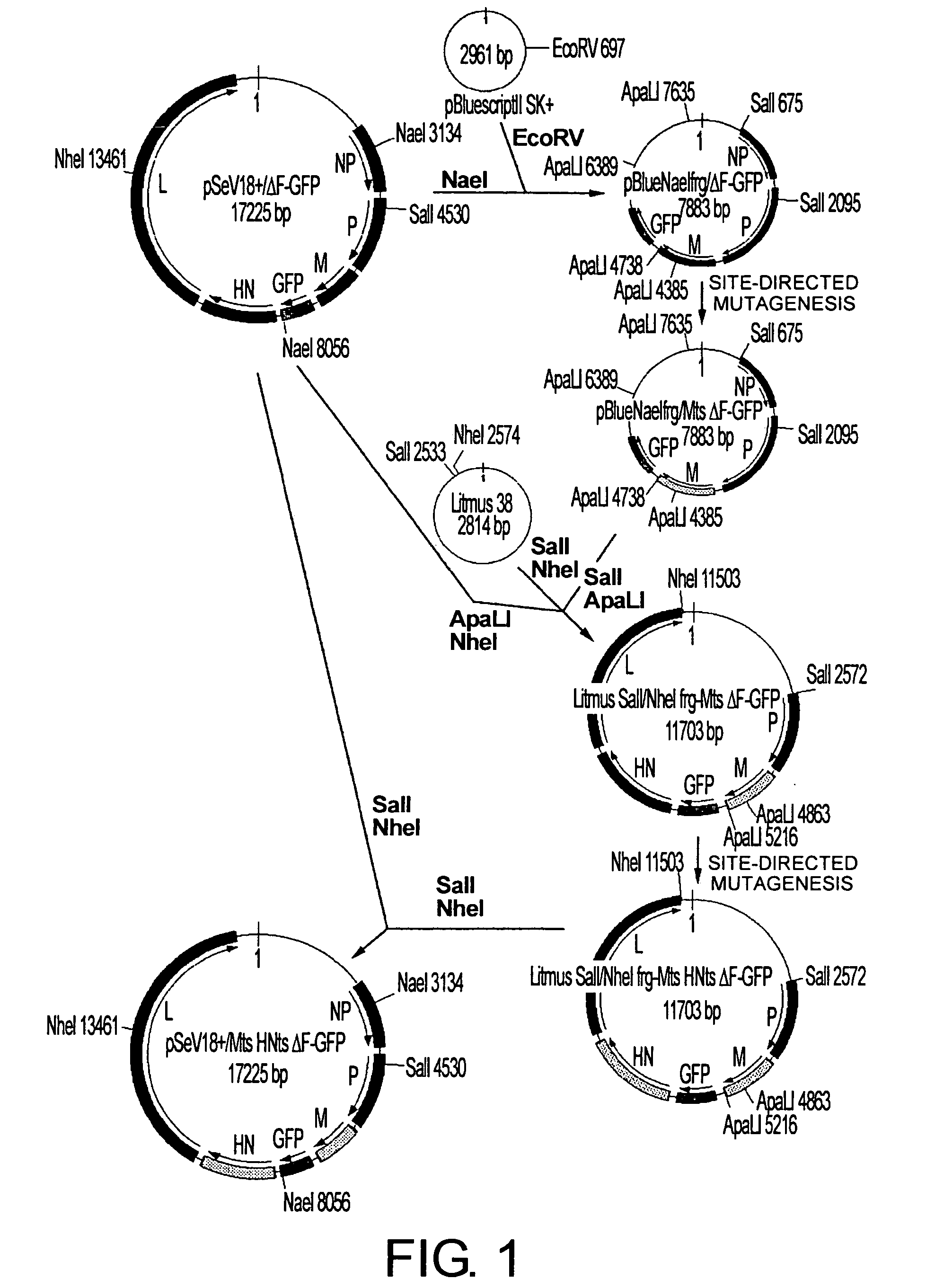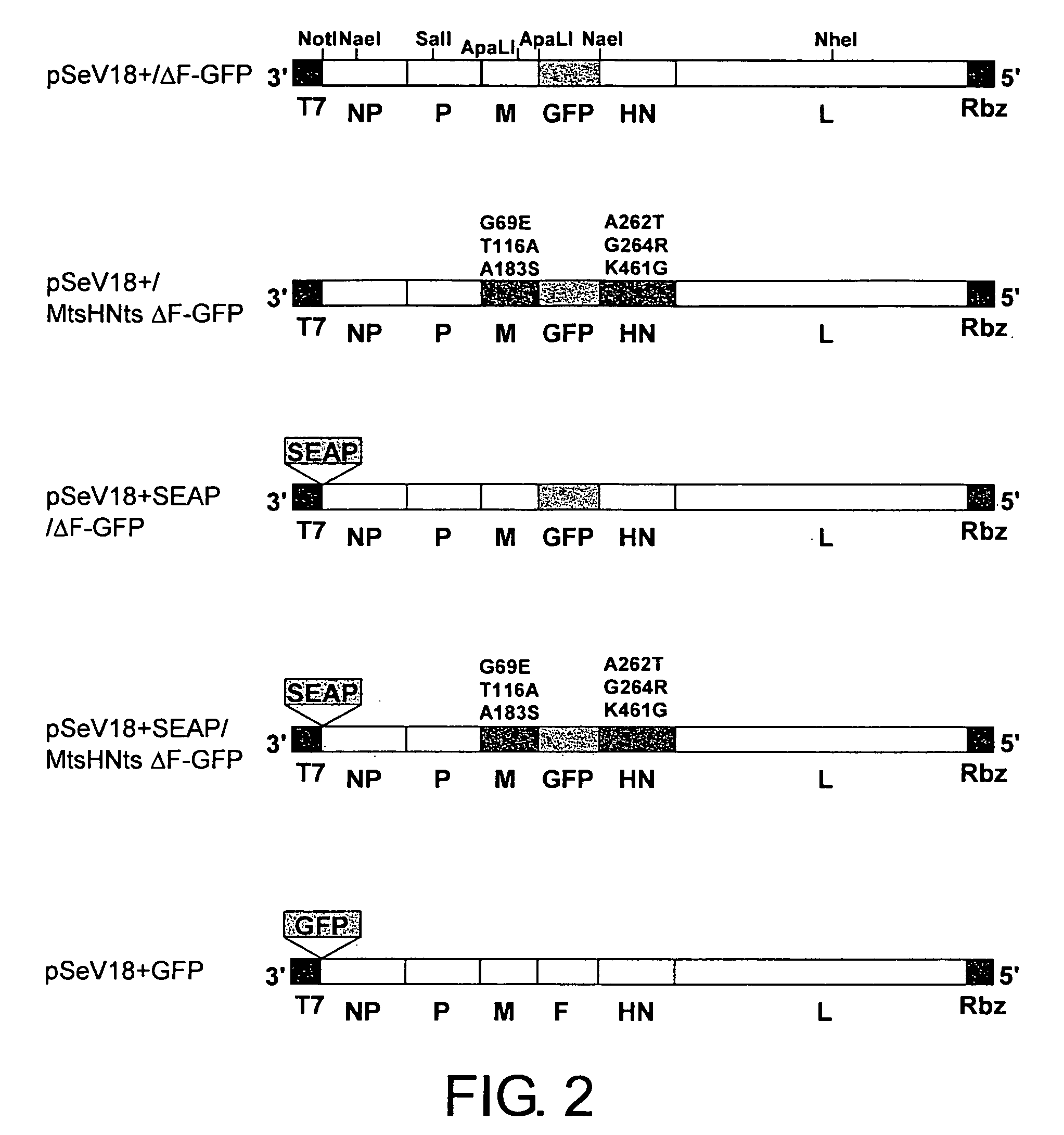Vectors with modified protease-dependent tropism
a protease-dependent, cell-fusion technology, applied in the direction of peptides, drugs, viruses, etc., can solve the problems of limited proliferation of viruses carrying wild-type f protein, secondary release of viruses from cells, etc., to achieve high expression levels, lower expression levels, and high expression levels
- Summary
- Abstract
- Description
- Claims
- Application Information
AI Technical Summary
Benefits of technology
Problems solved by technology
Method used
Image
Examples
example 1
Construction of a Temperature-Sensitive Mutant SeV Genome cDNA
[0211] An SeV genome cDNA in which temperature-sensitive mutations were introduced in M gene was constructed. FIG. 1, which shows a scheme that represents the construction of the cDNA, is described as follows. An F-deficient full-length Sendai viral genome cDNA containing the EGFP gene at the F deletion site (pSeV18+ / ΔF-GFP: Li, H. -O. et al., J. Virology 74, 6564-6569, 2000; WO 00 / 70070) was digested with NaeI. The M gene-containing fragment (4922 bp) was separated using agarose electrophoresis. After cutting the band of interest out, the DNA was recovered by QIAEXII Gel Extraction System (QIAGEN, Bothell, Wash.) and subcloned into pBluescript II (Stratagene, La Jolla, Calif.) at the EcoRV site (pBlueNaeIfrg-ΔFGFP construction). Introduction of temperature-sensitive mutations into the M gene of pBlueNaeIfrg-ΔFGFP was achieved using a QuikChange™ Site-Directed Mutagenesis Kit (Stratagene, La Jolla, Calif.), according to ...
example 2
Reconstitution and Amplification of Virus Introduced with Temperature-Sensitive Mutations
[0216] Viral reconstitution was performed according to the procedure reported by Li et al. (Li, H. -O. et al., J. Virology 74, 6564-6569, 2000; WO 00 / 70070). F protein helper cells, prepared using an inducible Cre / loxP expression system, were utilized to reconstitute F-deficient viruses. The system uses a pCALNdLw plasmid, designed for Cre DNA recombinase-mediated inducible gene product expression (Arai, T. et al., J. Virol. 72, 1115-1121, 1988). In this system, the inserted gene is expressed in a transformant carrying this plasmid using the method of Saito et al. to infect the transformant with a recombinant adenovirus (AxCANCre) expressing Cre DNA recombinase (Saito, I. et al., Nucleic Acids Res. 23, 3816-3821, 1995 ; Arai, T. et al., J. Virol. 72, 1115-1121, 1998). In the case of the SeV-F protein, the transformed cells comprising the F gene are herein referred to as LLC-MK2 / F7, and cells pe...
example 3
Effect of Culture Temperature (32° C.) on Viral Reconstitution
[0219] In the experimental reconstitution of viruses in which temperature-sensitive mutations were introduced (Example 2), P1 and all subsequent cultures were carried out at 32° C. This temperature was used because the reference virus, used for assessing the introduction of temperature-sensitive mutations, grows well at 32° C. (Kondo, T. et al., J. Biol. Chem. 268, 21924-21930, 1993; Thompson, S. D. et al., Virology 160, 1-8, 1987). Close examination of the experimental conditions revealed that, for SeV reconstitution (and for other viruses in addition to those in which temperature-sensitive mutations had been introduced), reconstitution efficiency was improved by carrying out P1 and subsequent cultures at 32° C., giving a high possibility of recovering viruses that were previously difficult to obtain.
[0220] There are thought to be two reasons for enhanced reconstitution efficiency at 32° C. The first point is that, whe...
PUM
 Login to View More
Login to View More Abstract
Description
Claims
Application Information
 Login to View More
Login to View More - R&D
- Intellectual Property
- Life Sciences
- Materials
- Tech Scout
- Unparalleled Data Quality
- Higher Quality Content
- 60% Fewer Hallucinations
Browse by: Latest US Patents, China's latest patents, Technical Efficacy Thesaurus, Application Domain, Technology Topic, Popular Technical Reports.
© 2025 PatSnap. All rights reserved.Legal|Privacy policy|Modern Slavery Act Transparency Statement|Sitemap|About US| Contact US: help@patsnap.com



